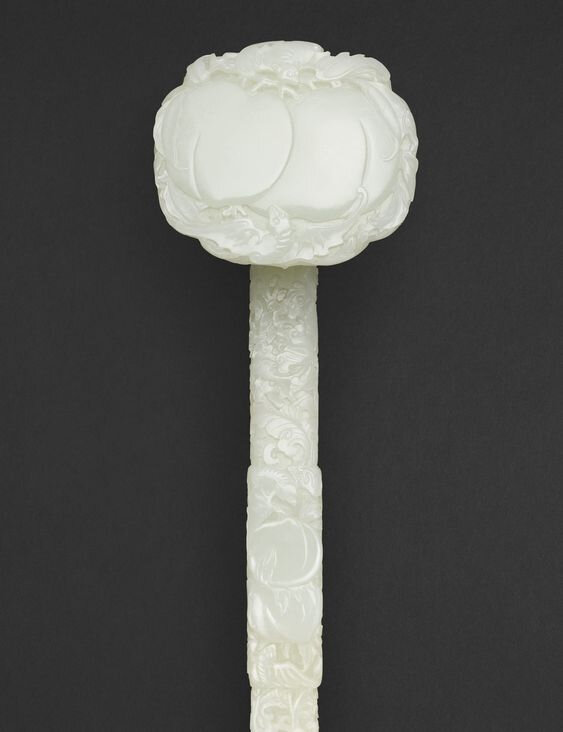A superb and finely carved white jade 'Longevity' ruyi sceptre, Qing dynasty, late 18th century – 19th century
Lot 104. A superb and finely carved white jade 'Longevity' ruyi sceptre, Qing dynasty, late 18th century – 19th century; 47 cm, 18 1/2 in. Estimate: 1,800,000 — 2,500,000 HKD (229,320 - 318,500 USD). Courtesy Sotheby's.
the large ruyi-shaped terminal worked in relief with two succulent peaches borne on curved stems issuing leaves around the sides, framed above and below by a pair of flying bats, their wings outstretched embracing the large fruits, the reverse decorated with a leafy meander in shallow relief, the elongated arched shaft similarly decorated in the middle and end with further flying bats and peaches, amidst densely worked undulating lotus scrolls in the round, the stone of an even white tone with faint milky inclusions, wood stand.
Exhibited: Ip Yee, Chinese Jade Carving, Hong Kong Museum of Art, Hong Kong, 1983, cat. no. 221.
Note: The entire surface of the present ruyi sceptre is intricately carved in relief with peaches and bats, chosen for their auspicious connotations. A design appropriate for imperial birthdays, this is a rare piece commissioned specifically for the occasion. "Superior men found the likeness of all excellent qualities in jade. Soft, smooth, and glossy, it appeared to them like benevolence," says Confucius in Liji: Pinyi [The Book of Rites: The Meaning of Interchange of Missions twixt Different Courts]. The embodiment by jade of the virtues of a gentleman, combined with the auspiciousness of the ruyimotif, thus presents a glimpse into the quintessence of Chinese culture.
In the Imperial Qing court, the consort chosen to be empress would be presented with a ruyi sceptre as a recognition of her newfound status. On the day before the wedding, such sceptres would be placed at the four corners of the marital bed to confer blessings on the consummation. As an imperial object, the ruyi was ubiquitous in court; as the sceptre has no practical function and could express good wishes suitable for any occasion, it was a gift often bestowed to foreign ambassadors by the emperor, whom himself would receive the same gift during birthdays and coronations.
The history of ruyi dates back to the Eastern Han dynasty. According to the Ming Daoist Manual Tianhuang Zhidao Taiqing Yuce: Xiuzhenqi Yongzhang, ruyi was first invented by the Yellow Emperor or Huangdi as a weapon against his rival Chiyou, and afterwards took the form of a flower with a shaft, with which evil spirits can be exorcised and good fortune bestowed.

/https%3A%2F%2Fprofilepics.canalblog.com%2Fprofilepics%2F1%2F0%2F100183.jpg)
/https%3A%2F%2Fstorage.canalblog.com%2F03%2F02%2F119589%2F96711876_o.jpg)
/https%3A%2F%2Fstorage.canalblog.com%2F11%2F31%2F119589%2F94773502_o.jpg)
/https%3A%2F%2Fstorage.canalblog.com%2F20%2F83%2F119589%2F94772815_o.jpg)
/https%3A%2F%2Fstorage.canalblog.com%2F26%2F72%2F119589%2F75604929_o.jpg)
/https%3A%2F%2Fstorage.canalblog.com%2F59%2F60%2F119589%2F26458628_o.jpg)





/image%2F1371349%2F20240406%2Fob_a54acc_435229368-1644755382961141-18285727260.jpg)
/image%2F1371349%2F20240229%2Fob_b1ea4c_429582962-1625285201574826-43586635599.jpg)
/image%2F1371349%2F20240229%2Fob_84bc3b_429558450-1624783464958333-37673404077.jpg)
/http%3A%2F%2Fstorage.canalblog.com%2F36%2F88%2F119589%2F129555285_o.jpg)